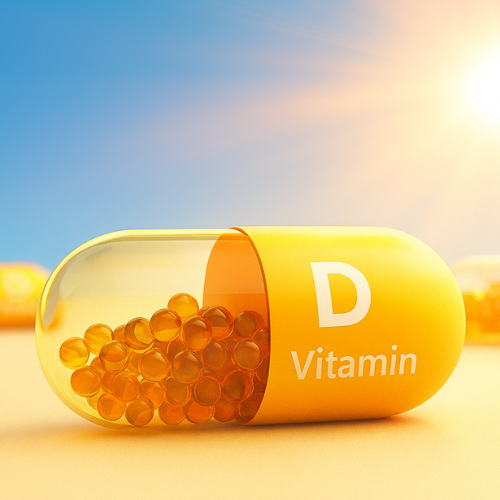Vitamin D: More than just a vitamin

Also known as the “sunshine vitamin”, vitamin D is well–known for its role in supporting strong bones, but that’s just the tip of the iceberg. At the cellular and genetic level, vitamin D acts more like a hormone than a typical nutrient, influencing hundreds of processes in nearly every cell. Its reach extends into nearly every tissue, including your brain, your heart, and even your DNA.
What is Vitamin D?
Vitamin D is a fat-soluble vitamin, but functionally, it behaves more like a hormone. Your body produces it naturally when your skin is exposed to sunlight - specifically UVB rays. From there, it undergoes two key activation steps: first in the liver, and then in the kidneys, where it’s converted into its active form, calcitriol.
This active form of vitamin D travels throughout the body, binding to receptors in cells and influencing systems including immune function, inflammation, detoxification, and gene expression.
What Does Vitamin D Do?
Vitamin D influences your health by working directly with your genes. It forms a complex by attaching to the Vitamin D Receptor (VDR), which is found in almost every cell in your body. This complex acts as a transcription factor, meaning it can turn specific genes on or off. This allows vitamin D to influence the expression of hundreds of genes.1
Vitamin D influences the expression of hundreds of genes, impacting vital processes such as immune response, inflammation, and cellular energy production.
Genes like MTHFR (related to methylation) and NFE2L2 (related to antioxidant defence) are among those affected by vitamin D.2 In immune cells called monocytes, researchers have identified nearly 200 genes that are directly regulated by vitamin D, highlighting just how widespread its genetic impact can be.3
Benefits of Vitamin D
Vitamin D is essential for bone health - without it, your body only absorbs 10–15% of dietary calcium4; but its benefits go far beyond bones. Through its genetic and cellular influence, vitamin D also helps to:
- Regulate how cells grow, repair, and function
- Boost mitochondrial energy production at the cellular level
- Strengthen and balance the immune system
- Reduce chronic inflammation
- Support detoxification and protect against oxidative stress
- Maintain healthy methylation and gene expression pattern
Despite its importance, vitamin D deficiency remains incredibly common worldwide.
Low levels can show up in different ways. Early signs may be subtle and often mistaken for other issues, but can include:
- persistent fatigue
- low mood
- frequent colds or infections
- muscle weakness
- joint or bone pain
- slow wound healing
- hair loss
- brain fog
Deficiency in vitamin D is linked to a wide range of chronic health issues, including autoimmune conditions, metabolic dysfunction, mood disorders, and neurodegenerative diseases. Clinical studies have shown benefits in conditions such as depression, seasonal affective disorder, asthma, psoriasis, rheumatoid arthritis, rickets, and tuberculosis.5,6
A study of over 12,000 older adults found that vitamin D supplementation was associated with a 40% lower risk of developing dementia.7
This protective benefit was particularly strong in women, individuals without the APOE ε4 genetic variant, and those who began supplementation before any cognitive decline set in. Researchers believe this protective effect stems from vitamin D’s role in regulating inflammation, clearing amyloid plaques, supporting mitochondrial health, and modulating gene activity in the brain. While more research is underway, these findings add to a growing body of evidence that maintaining healthy vitamin D levels may support long–term brain health and resilience.
Vitamin D Supplementation
For most people, getting enough vitamin D from sunlight alone is difficult - especially if you live in a colder climate, work indoors, or wear sunscreen regularly (as you should). That’s why dietary supplements are a far more reliable and practical way to maintain healthy vitamin D levels year–round.
There is a lack of widespread understanding around how much vitamin D is required to support optimal health. Many lab reference ranges are set too low to reflect truly functional levels, particularly for individuals whose genetic or lifestyle factors reduce their ability to absorb or activate vitamin D effectively. As a result, many supplements provide doses that are too low to raise and maintain vitamin D levels in an optimal range.
Why You Need Vitamin K2 with Vitamin D
When supplementing with vitamin D, your body becomes better at absorbing calcium from food and supplements. But that calcium needs to go to the right places.
This is where vitamin K2 plays a critical role. It helps direct calcium into your bones and away from tissues like arteries and kidneys.
Taking vitamin K2 alongside vitamin D, especially in the MK-7 form, helps ensure that calcium metabolism stays balanced and supports both bone strength and cardiovascular health.
Interactions With Other Nutrients
Vitamin D doesn’t work in isolation, several other nutrients are essential for it to function optimally.
Magnesium plays a central role in vitamin D metabolism, acting as a cofactor in the enzymes that convert it into both its storage form and active form. Without adequate magnesium, vitamin D supplementation may be less effective.
Zinc also supports vitamin D activity by influencing the expression of the vitamin D receptor (VDR), which determines how well cells respond once vitamin D is activated.
Additionally, vitamin D appears to work synergistically with omega-3 fatty acids, particularly EPA and DHA, to support immune regulation, reduce inflammation, and promote brain health.
Can you have too much vitamin D?
Technically, yes — but toxicity is rare and usually involves extremely high doses taken long–term without medical supervision.
One large clinical program involving over 4,700 patients used daily doses of vitamin D ranging from 5,000 to 50,000 IU per day depending on individual needs. No cases of vitamin D toxicity or high calcium levels were reported, even at the highest doses.8 This shows that with proper medical guidance and blood testing, high–dose vitamin D can be used safely – especially in people with significant deficiency or health conditions that increase their needs.
How Much Vitamin D Should You Take?
The right dose of vitamin D isn’t one-size-fits-all. Your ideal intake depends on many factors, including sun exposure, melanin levels, lifestyle, and your genes.
How Your Genes Affect Your Vitamin D Needs
Your ability to absorb, activate, and respond to vitamin D isn’t just about sun exposure or diet — it’s also influenced by your genes. Each person carries unique variations in their DNA that affect how efficiently their body handles vitamin D at every step: from converting sunlight into the storage form, to activating it, and using it inside cells.
Some of these genetic variations, known as single nucleotide polymorphisms (SNPs), occur in key genes involved in vitamin D transport (like GC), activation (CYP2R1, CYP27B1), synthesis (DHCR7), and receptor binding (VDR). These tiny changes can impact how much vitamin D you need to maintain optimal levels — and why some people struggle with deficiency even when their lifestyle seems healthy.
Understanding your vitamin D–related genes can offer a more personalised approach to supplementation. Rather than guessing, you can tailor your dose and strategy based on how your body is likely to process and respond to vitamin D. It’s a great example of how your genes can help shape your unique nutritional needs.
Your Next Steps
Like the sun itself, vitamin D supports life at the deepest level — from your bones and brain to your genes and cells. Understanding how your body handles vitamin D is the first step toward optimising your health.
MyGene’s Healthspan programs include a dedicated vitamin D gene panel, which helps identify how your genes may affect your ability to absorb, activate, and respond to vitamin D. Pairing this with a blood test for serum 25(OH)D gives you a complete picture, combining genetic insights with current status to guide a more personalised and effective plan.
Before starting any supplementation, it is recommended that you consult a healthcare professional to develop a targeted strategy, which may include vitamin K2 to support safe and effective calcium metabolism.
Further Reading
1. Carlberg, C. (2022) ‘Vitamin D and its target genes’, Nutrients, 14(7), p. 1354. doi:10.3390/nu14071354.
2. Liu, N. et al. (2024) ‘The improvement of homocysteine-induced myocardial inflammation by vitamin D depends on activation of NFE2L2 mediated MTHFR’, International Immunopharmacology, 127, p. 111437. doi:10.1016/j.intimp.2023.111437.
3. Nurminen, V., Seuter, S. and Carlberg, C. (2019) ‘Primary vitamin D target genes of human monocytes’, Frontiers in Physiology, 10. doi:10.3389/fphys.2019.00194.
4. Nair, R. and Maseeh, A. (2012) ‘Vitamin D: The “sunshine” vitamin.’, Journal of pharmacology & pharmacotherapeutics, 3(2), pp. 118–126. doi:10.4103/0976-500X.95506.
5. Campbell, J. (2023) Vitamin D doses. Available at: https://www.youtube.com/watch?v=E3_t%E2%80%93EQIy0s.
6. Lewis, P. (2023) Dr. Peter Lewis explaining the benefits of Vitamin D.
Available at:
https://www.youtube.com/watch?v=0WIwJofiHjA
7. Ghahremani, M. et al. (2023) ‘Vitamin D supplementation and incident dementia: Effects of sex, apoe, and Baseline Cognitive Status’, Alzheimer’s & Dementia: Diagnosis, Assessment & Disease Monitoring, 15(1). doi:10.1002/dad2.12404.
8. McCullough, P.J., Lehrer, D.S. and Amend, J. (2019) ‘Daily oral dosing of vitamin D3 using 5000 to 50,000 international units a day in long-term hospitalized patients: Insights from a seven Year experience’, The Journal of Steroid Biochemistry and Molecular Biology, 189, pp. 228–239. doi:10.1016/j.jsbmb.2018.12.010.




